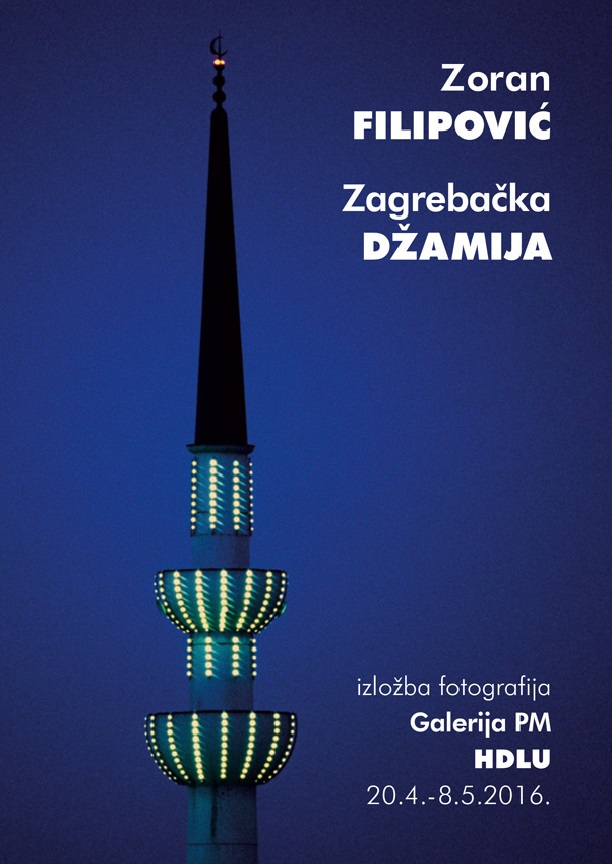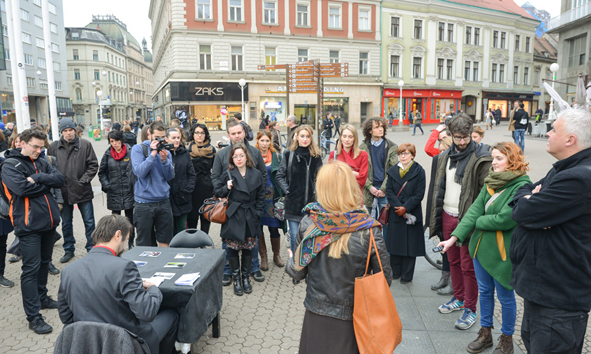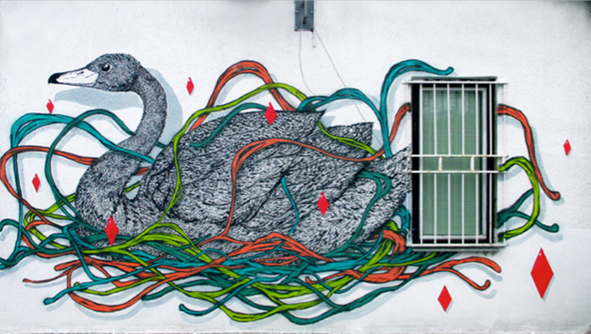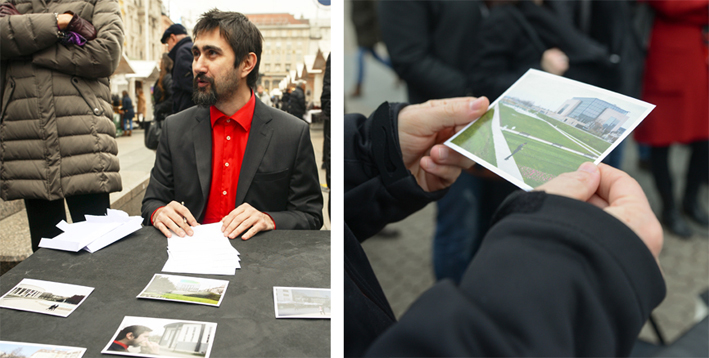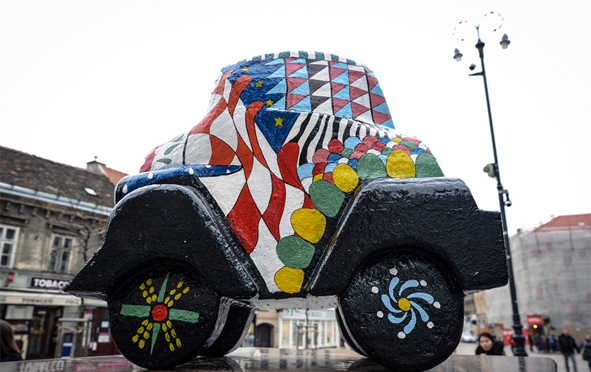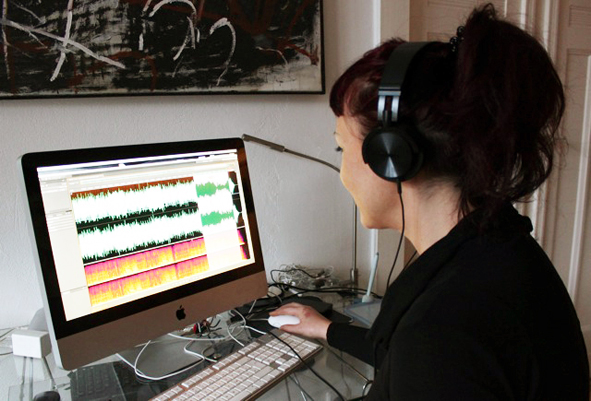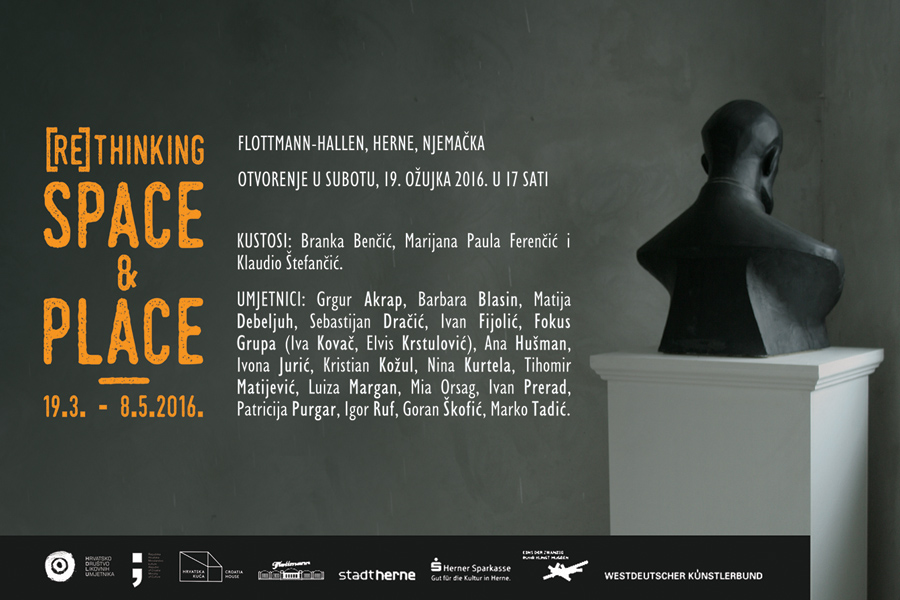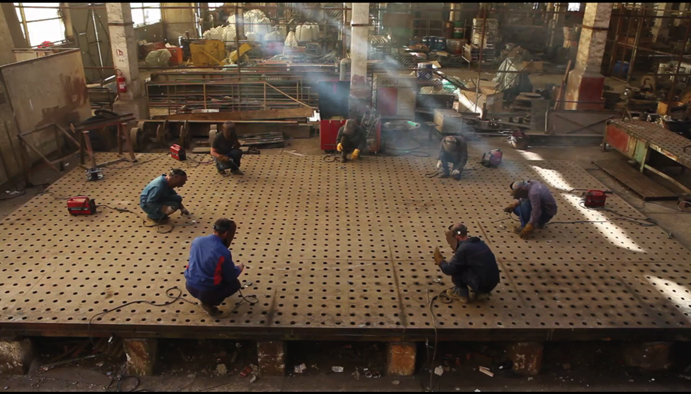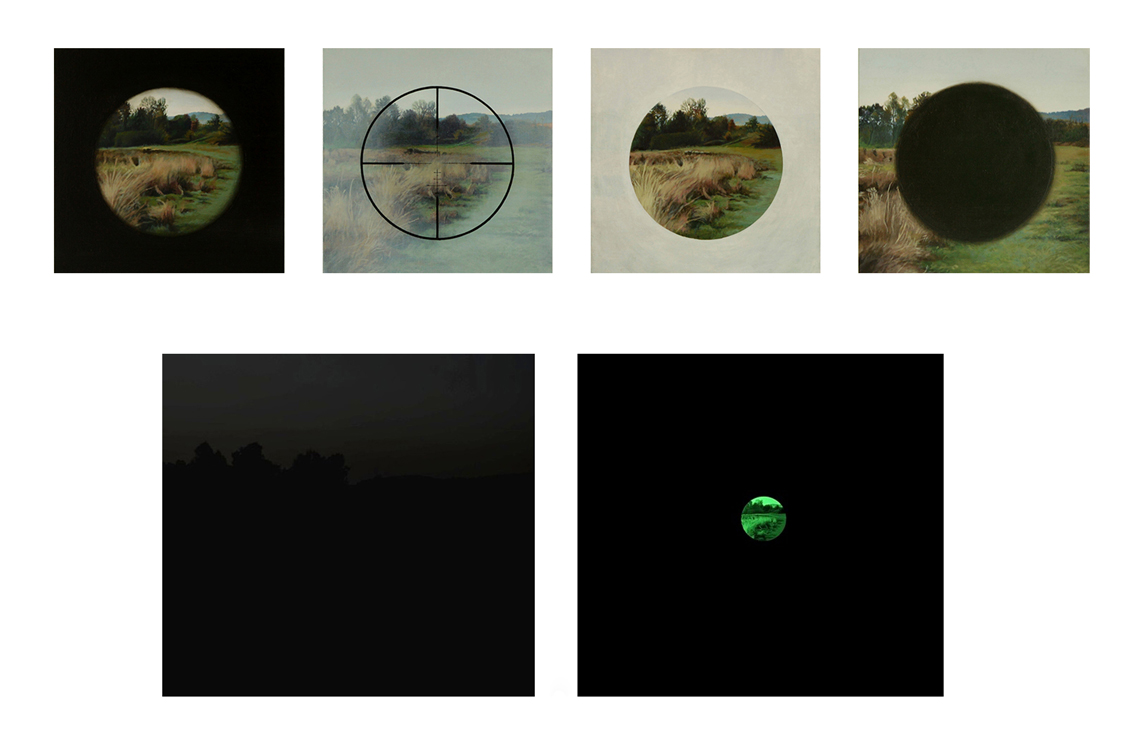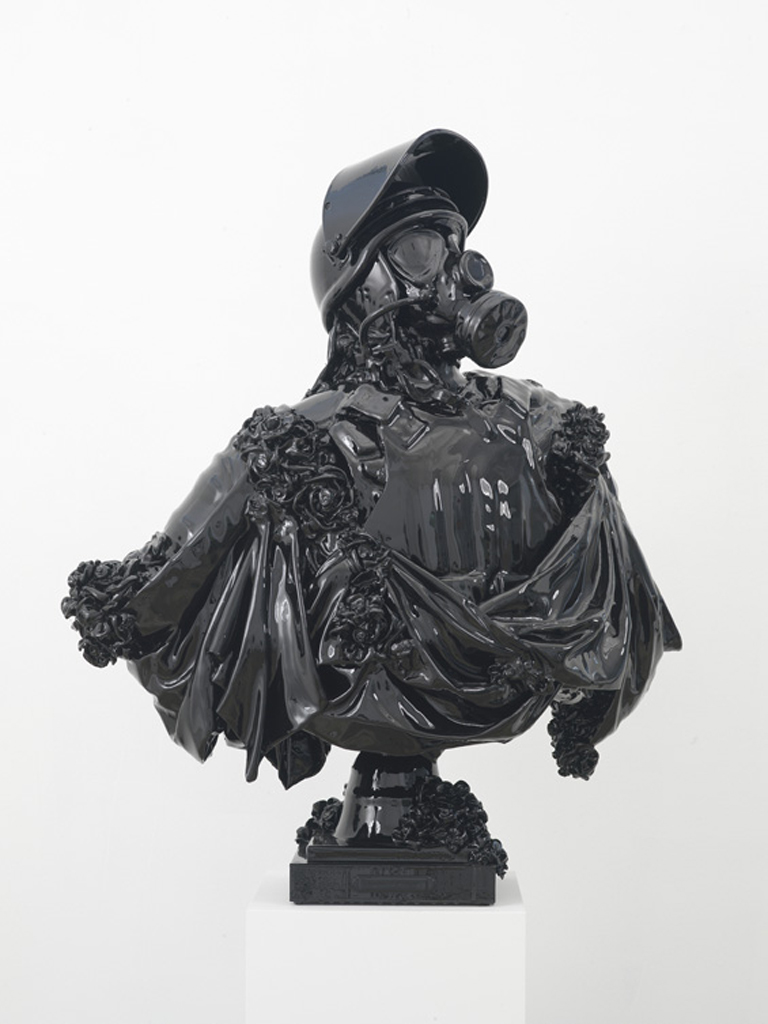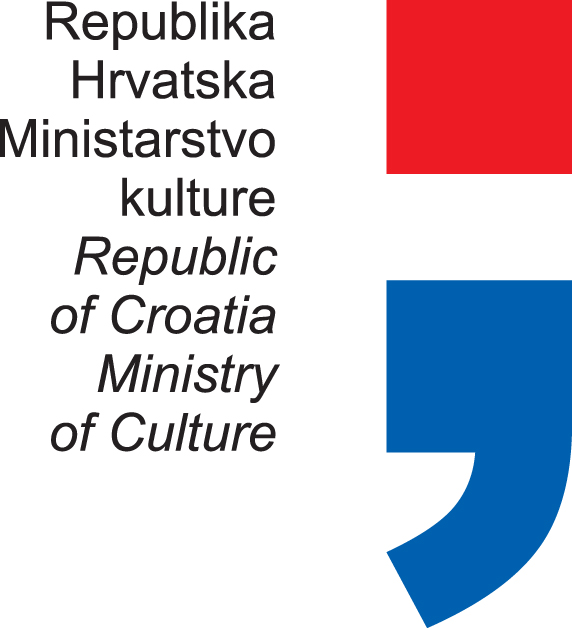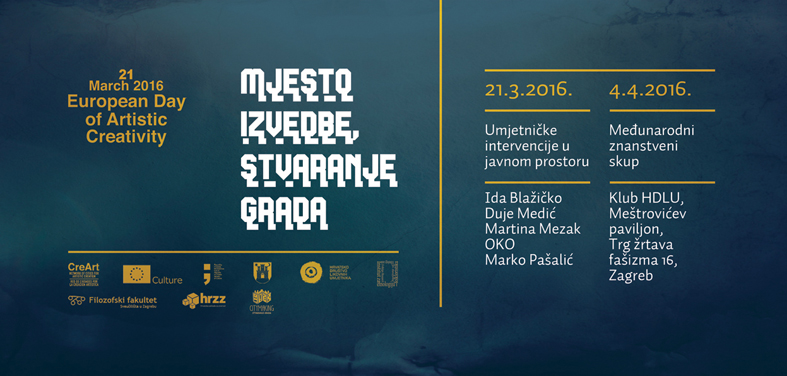Category: Events
THE BOOK OF LAND: SPRING
Helga Goran
Prsten Gallery
April 20 – May 8
ZAGREB MOSQUE
Zoran Filipović
Gallery PM
April 20 – May 8
The celebration of the one-hundredth anniversary of the legal
recognition of Islam in Croatia in 2016
Exhibition opening: Wednesday, April 20, 2016 at 7pm
EUROPEAN DAY OF ARTISTIC CREATIVITY:
PERFORMANCE SITE, CITY-MAKING
A walk through artistic interventions in public space
As part of the European Day of Artistic Creativity project, on March 21. five artists OKO, Ida Blažičko, Marko Pašalić, Duje Medić and Martina Mezak performed interventions at chosen locations in the city’s public space through medium of sculpture, mural, art installation, performans and and sound installation.
A walk with a guided tour for the public through artistic interventions in public space, in the presence of the artists, project managers Dr.Sc. Nevena Škrbić Alempijević and Dr.Sc. Josip Zanki, the President of the Croatian Association of Artists and the students of ethnology and cultural anthropology of the Faculty of Humanities and Social Sciences in Zagreb, was held on Monday.
Marina Mesar OKO, Student center
Swan, a mural by Marina Mesar OKO, emerged on one of the walls of the Student Centre, a place rich in cultural anthropologists of challenging history, symbolically filled with multiple meanings by its diverse functions. However, despite a complex historical context offering several potential reference points, OKO opted for a somewhat more personal approach, by focusing on her own understanding and experience of this space. Since she has already created several works in this location, she focused on upgrading her own history. She painted over her old work, created eight years ago, and created a new one in the same place, creating thus a kind of her own palimpsest and, to some extent, renouncing of. The work was created in collaboration with the student Jozefina Ćurković.
Ida Blažičko, Octogon passage
The artist Ida Blažičko presented a hanging installation in the centre of the Octagon passage. The work titled Aithérios is made of natural materials embroidered with thin bamboo. Ultra-light and airy, the material has a certain glow and transparency and the colour changes depending on the intensity of light and time of day. The artist chose the centre of the Octogon passage precisely because the dome has become invisible, and people became oblivious to the beauty of the space. The aim of the installation is to enrich the space and emphasize its magnificence and attract the attention of passers by who would then also notice the dome with stained glass windows. The development of the idea, creation of the work and its installation was done in collaboration with the student Katija Crnčević.
Marko Pašalić, The Ban Jelačić Square
Artistic intervention, performance by Marko Pašalić on the Ban Jelačić Square is the last in a series of six photo-performances the artist performed at various locations around Zagreb, under the name Grad – igralište nasumičnog pristupa [The City – Playground of Random Approach]. The artist selected Ban Jelačić Square as the place of his last performance, which is the central public space of the City of Zagreb, the place of social communication and expression of public opinion of its citizens in relation to public policies. The performance was designed as an experiment that questions the theories of sovereignty by referring to the philosophers like Carl Schmitt and Giorgio Agamben. The work was created in collaboration with Klara Tončić, an ethnology and comparative anthropology student.
Duje Medić, The Europe Square
Duje Medić’s intervention in space is placed on the Europe Square in Zagreb (the crossroads between Cesarčeva and Bakačeva Street). Polystyrene installation Autić s posebnim potrebama za trg s posebnim potrebama [Toy Car With Special Needs for the Square With Special Needs], which resembles a toy-car, was created as a reaction to the controversial circumstances surrounding the creation of the Square and the critique of its architecture, urbanism and design, and it tries to intervene into space using humour. The work was created in collaboration with Ena Grabar, an ethnology and comparative anthropology student.
Martina Mezak, Trg žrtava fašizma
Martina Mezak’s work – Laughing Butterflies is a sound installation, set as a part of the Home of the Croatian Association of Artists, Meštrović Pavillion (Trg žrtava fašizma). With the sounds of laughter without bodies, in this multi-layered, polyphonic and controversial space the artist introduced a unique defamiliarization as the experience of an urban place, playfulness and fun from the myth of “laughing butterflies“ of the Pueblo peoples. By abstracting laughter to its primal, archetypal, and by emphasizing its ambivalence – well familiarized with the history of the building and the place, and with her own intimate connection with it, with a subversive twist the author questions the (dis)order of historical physical and symbolic interventions in this space “from above“ and “from below“, as well as their evaluations. The work was created in collaboration with the student/researcher Tomislav Augustinčić.
The Artistic interventions in public space happening on March 21 are a part of the European Day of Artistic Creativity project, through which HDLU is marking the EU project CreArt. The project is implemented in cooperation with the Department of Ethnology and Cultural Anthropology, University of Zagreb and the Institute of Ethnology and Folklore in Zagreb as a part of the project City-making: space, culture and identity (HRZZ). The documentation was accomplished in collaboration with five students from the Department for Ethnology and Cultural Anthropology of the Faculty of Humanities and Social Sciences at the University of Zagreb.
Consequently, an international scientific conference Performance site and city-making is going to be held on April 4 in the seat of HDLU, with the goal of addressing the issue of sites and non-sites as platforms for creating the meaning of the city, but at the same time as generators of artistic interventions. The meeting will be open to the interested public, and a detailed schedule can be downloaded HERE.
The organizers:
With the support of:
(re)thinking Space&Place
GROUP EXHIBITION OF CROATIAN FINE ARTISTS IN GERMANY
Flottmann-Hallen, Herne, Germany
March 19 – May 8, 2016.
Tihomir Matijević – Grounded bust, 2008.
In period from March 19 – May 8, 2016 a group exhibition (re)thinking Space&Place, is presenting 19 Croatian artists and is being held at the gallery space of Flottmann-Hallen in Herne, Germany. The curatorial concept was realized in collaboration with three prominent Croatian curators, who have worked on the concept through various artistic media; Branka Benčić through visual arts, Marijana Paula Ferenčić through painting and Klaudio Štefančić through sculpture.
The exhibition presents the following artists: Grgur Akrap, Barbara Blasin, Matija Debeljuh, Sebastijan Dračić, Ivan Fijolić, Fokus Grupa (Iva Kovač, Elvis Krstulović), Ana Hušman, Ivona Jurić, Kristian Kožul, Nina Kurtela, Tihomir Matijević, Luiza Margan, Mia Orsag, Ivan Prerad, Patricija Purgar, Igor Ruf, Goran Škofić, Marko Tadić.
Opening of the exhibition was held on March 19 and was attended by the Consul General for Germany, Düsseldorf Mr. Zvonko Plećaš, Croatian curators Klaudio Štefančić and Branka Benčić, Croatian artists Kristian Kožul and Luiza Margan, president of HDLU PhD Josip Zanki, director of Flottmann-Hallen Gallery Mrs. Jutta Laurinat and chairmain of WKB Ekkehard Neumann.
The exhibition is the result of an international cooperation between the Croatian Association of the Fine Artists (HDLU) and the Westdeutscher Kunstlerbund (WKB), of which the previous was the exhibition of WKB in 2014. in the PM gallery at Croatian Association of the Fine Artists.
EXHIBITION CATALOG and detailed curatorial concept is available HERE.
Organisers:
Patrons:
THE OTHER SIDE PROJECT II – Scars
Nguyen Thi Thanh Mai
Curator:
Marija Lopac
PM Gallery
March 24 – April 10, 2016
Exhibition opening: Wednesday, March 9, 2016 at 6pm
(re)thinking Space&Place
GROUP EXHIBITION OF CROATIAN FINE ARTISTS IN GERMANY
Flottmann-Hallen, Herne, Germany
March 19 – May 8, 2016.
Opening: March 19 at 5:00pm
Tihomir Matijević – Grounded bust, 2008.
From March 19 – May 8, 2016 a group exhibition (re)thinking Space&Place, presenting 19 Croatian artists, is being held at the gallery space of Flottmann-Hallen in Herne, Germany. The curatorial concept was realized in collaboration with three prominent Croatian curators, who have worked on the concept through various artistic media; Branka Benčić through visual arts, Marijana Paula Ferenčić through painting and Klaudio Štefančić through sculpture.
The exhibition presents the following artists: Grgur Akrap, Barbara Blasin, Matija Debeljuh, Sebastijan Dračić, Ivan Fijolić, Fokus Grupa (Iva Kovač, Elvis Krstulović), Ana Hušman, Ivona Jurić, Kristian Kožul, Nina Kurtela, Tihomir Matijević, Luiza Margan, Mia Orsag, Ivan Prerad, Patricija Purgar, Igor Ruf, Goran Škofić, Marko Tadić.
Goran Škofić – Sector, 2015.
As pointed out by Branka Benčić, the works of the selected artists are focused on the medium of video as a means of expression and the language of moving images. They take different positions on the forms of representation, issues of individual or cultural identity, space and architecture, and explore them by focusing their interest on different topics, artistic strategies and procedures – taking as a starting point monuments, strategies related to performance, body, self-representation, the question of language and cultural context, heritage, the issues of work, production and deindustrialisation, interest in the built or natural environment, by pointing to the fact that the image of a space is always a form of construction and matter of representation, whether it is about abandoned spaces, remnants of modernity, the landscape or artificial and fantastic space of animation.
Patricija Purgar – Surcease of Target’s Activity, 2015.
– Light-gathering Ability, 2015.
On the other hand, Marijana Paula Ferenčić notes that the whole composed of fragments of painted views, just like a mosaic, connects and separates different subjective narratives created using a rational visual language, but also with artistic intuition. The world of two-dimensional exists thus in the illusion of the three-dimensional, forming the unity of view in all its emotional vastness and performative subtleties.
Kristian Kožul – Untitled, 2011.
Klaudio Štefančić concludes that the artistic value of public sculpture cannot be perceived without the analysis of social relations. It does not suffice anymore to interpret public sculpture within the framework of modernist concept of formal innovation. The selection of works in this exhibition is not based on importance of their volumes, masses or contours, planes and anatomies of the portrayed figures, etc., but on their potential place in a wider social context. However, public sculpture, in any form, is no longer a privileged medium of visual expression.
Opening of the exhibition will be held on March 19 and will be attended by the Consul General for Germany, Düsseldorf Mr. Zvonko Plećaš, Croatian curators Klaudio Štefančić and Branka Benčić, Croatian artists Kristian Kožul and Luiza Margan, president of HDLU PhD Josip Zanki, director of Flottmann-Hallen Gallery Mrs. Jutta Laurinat and chairmain of WKB Ekkehard Neumann.
The exhibition is the result of an international cooperation between the Croatian Association of the Fine Artists (HDLU) and the Westdeutscher Kunstlerbund (WKB), of which the previous was the exhibition of WKB in 2014. in the PM gallery at Croatian Association of the Fine Artists.
EXHIBITION CATALOG and detailed curatorial concept is available HERE.
Organisers:
Patrons:
EUROPEAN DAY OF ARTISTIC CREATIVITY:
PERFORMANCE SITE, CITY-MAKING
artistic interventions in public space and the international conference
As part of the EU project CreArt, Croatian Association of Fine Artists from Zagreb (HDLU) is marking the European Day of Artistic Creativity by organizing a project Performance site, city-making. The project is implemented in cooperation with the Department of Ethnology and Cultural Anthropology, University of Zagreb and the Institute of Ethnology and Folklore in Zagreb as a part of the project City-making: space, culture and identity (HRZZ). The project is designed within two events: the presentation of artistic interventions in five locations in the city’s public space on March 21, and the international conference on April 4 2016 in the HDLU Club.
Five artists, Ida Blažičko, Duje Medić, Martina Mezak, Marko Pašalić and OKO are going to perform interventions at chosen locations in the city’s public space. Visits of the locations with an expert guide and the opportunity to talk to the artists will be arranged for the public on March 21. Five students from the Department for Ethnology and Cultural Anthropology of the Faculty of Humanities and Social Sciences at the University of Zagreb will be documenting the project on the locations chosen for artistic interventions.
Consequently, an international scientific conference Performance site and city-making is going to be held on April 4 in the seat of HDLU, with the goal of addressing the issue of sites and non-sites as platforms for creating the meaning of the city, but at the same time as generators of artistic interventions. The conference will be open to the public, and a detailed program will be announced by March 16, 2016.
The project is going to be documented through an accompanying book, which will include the papers presented at the scientific conference and the documentation of the artistic interventions in public space.
The purpose of the project is to combine artistic creation and scientific research as a possible means of encouraging new creative processes aimed at sensitization and transformation of public space as the archetype site for acting outside corporative models and dominant cultural industries.
The project is co-funded by the EU Culture Programme 2007 – 2013 as part of the EU project CreArt, by the Croatian Science Foundation as a part of the project City-making: space, culture and identity, and supported by Zagreb’s City Office for Education, Culture and Sports and the Ministry of Culture.
CreArt project in more detail
Creart is a network of public and private institutions established in European cities, with experience in cultural management and dedicated to the development of visual arts. The project was selected as part of the EU Culture Programme 2012 – 2017. Over the recent months, it has developed into a network of 13 partner cities and institutions, and as such represents the cultural diversity and richness of Europe. To represent the city of Zagreb, CAVA joined as partner at the end of 2013. The backbone of the project is to promote and encourage creativity and creation by supporting the creative industries through activities such as holding conferences on a regular basis, organizing residential programs, exhibitions, educational seminars and workshops, as well as monitoring the progress of individual cities. CreArt focuses on the research of culture in the medium- and medium-major sized European cities, affects change in the partner cities, monitors the successful implementation of plans, reports on and publishes the results, and transmits successful forms on the less successful cities.
More details:
http://www.creart-eu.org/presentation
City-making: space, culture and identity project in more detail
The project is aimed at untangling and comprehending the multiple, multi-layered and interdependent actors, factors and processes of contemporary transformations in the Croatian capital, Zagreb. Two dimensions of the project are singled out as crucial to the transformation of contemporary cities – the politics of public spaces and the politics of difference. Both constitute knots at which global political, economic and cultural flows meet and collide with local imaginaries, interests and developments, bringing about the restructuring of the city and its identity. The project also emphasizes the importance of including city dwellers in these processes, and investigates how they remake, recreate and reconstruct the given social, cultural and spatial landscape (cityscape), adding cultural meaning to it. The focus of the project, the concept of “city-making”, thus refers to a comprehensive construction and articulation of urban life. Art created in public space serves as one segment in creating the meaning of the city and its complexity.
The project is financed by Croatian Science Foundation (2014.-2018.).
More details about the project: www. citymaking.eu
The organizers:
With the support of:


